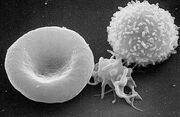
A scanning electron microscope (SEM) image of a normal red blood cell, a blood platelet, and a white blood cell.
Blood is the fluid which circulates through the heart, arteries, veins, and capillaries. Composed of red blood cells, white blood cells, blood platelets, and an interstitial fluid called plasma. Blood delivers nutrition and oxygen for tissues far from food and air supply, and transports waste from the tissues to the excretory organs. Blood also provides thermal and chemical regulation to the body and aids in preventing infection by transporting antibodies. [1]
Blood Production[]
All blood cells are produced in the bone marrow.[2] In children, most bones produce blood. Over time this gradually diminishes to just the bones of the vertebrae, sternum, ribs, pelvis and small parts of the upper arm and leg. Bone marrow that actively produces blood cells is called red marrow, and bone marrow that no longer produces blood cells is called yellow marrow. The process by which the body produces blood is called hematopoiesis. All blood cells (RBCs, WBCs and platelets) originate from the same type of cell, called the pluripotential hematopoietic stem cell. This group of cells has the potential to form any of the different types of blood cells and also to reproduce itself. This cell then forms committed stem cells that will form specific types of blood cells.
Red Blood Cells[]
Red blood cells (erythrocytes)[3] are the most common type of blood cell and the body's principal means of delivering oxygen to the body tissues. In addition to this, they deliver nutrients, such as fat and carbohydrates, to the cells where they are needed to produce ATP. This is exchanged for metabolic by-products, such as lactic acid, carbon dioxide, and water; carbon dioxide is transported to the lungs where it is breathed out, water is subsequently discharged from the body through perspiration or urination, and lactic acid is taken to the liver where it is metabolized or oxidized.[4]
Red blood cells are terminally differentiated, meaning they can never divide.[3] Red blood cells are filled with hemoglobin (Hgb), a molecule that can bind to oxygen. In humans, red blood cells develop in bone marrow, take the form of flexible biconcave disks, lack a cell nucleus, subcellular organelles and the ability to synthesize protein, and live for about 120 days[5] and then are ingested by phagocytic cells in the liver and spleen. Some 3 million RBCs die and are scavenged by the liver each second.[3] The red cell is enclosed in a thin membrane that is composed of chemically complex lipids, proteins, and carbohydrates. Extraordinary distortion of the red cell occurs in its passage through minute blood vessels, many of which have a diameter less than that of the red cell.[6] When the deforming stress is removed, the cell springs back to its original shape. The red cell easily tolerates bending and folding, but if significant stretching of the membrane occurs, the cell is damaged or destroyed. The membrane is freely permeable to water, oxygen, carbon dioxide, glucose, urea, and certain other substances, but it is impermeable to hemoglobin.[6]
Anemia[]
Anemia is a shortage of RBCs and/or the amount of hemoglobin in them. Anemia has many causes, one of the most common being an inadequate intake of iron in the diet.[3]
White Blood Cells[]
White blood cells, or leukocytes,[1] are cells of the immune system which defend the body against both infectious disease and foreign materials. Several different and diverse types of leukocytes exist, but they are all produced and derived from a multipotent cell in the bone marrow known as a hematopoietic stem cell. Leukocytes are found throughout the body, including the blood and lymphatic system.[7] White blood cells are much less numerous than red blood cells (the ratio between the two is around 1:700). They also have nuclei and consist of lymphocytes and monocytes with relatively clear cytoplasm, and three types of granulocytes, whose cytoplasm is filled with granules.[3]
Platelets[]
Platelets, are involved in hemostasis leading to the formation of blood clots. Like red blood cells, platelets have no nucleus.[8] Platelets are formed when cytoplasmic fragments of megakaryocytes, which are very large cells in the bone marrow, pinch off into the circulation as they age.[6]
Plasma[]
Plasma is the liquid component of blood, in which the blood cells are suspended. It is yellow in color.[9] Plasma makes up about 55% of total blood volume, and is composed of mostly water (90% by volume).[6][10] Plasma carries not only the blood cells but also nutrients (sugars, amino acids, fats, salts, minerals, etc.), waste products (CO2, lactic acid, urea, etc.), antibodies, clotting proteins (called clotting factors), chemical messengers such as hormones, and proteins that help maintain the body's fluid balance.[9]
See Also[]
References[]
- ↑ 1.0 1.1 Donche, Dan (2008). FF Trainer Certification Guide. USA: Fatal Fitness.
- ↑ Bianco, Carl (n.d.). How Blood Works. How Stuff Works. Retrieved on 2008-10-02.
- ↑ 3.0 3.1 3.2 3.3 3.4 RCN (n.d.). Blood. RCN.com. Retrieved on 2008-10-02.
- ↑ Brookes, Douglas S. (2004). The Complete Book of Personal Training. Champaign, IL: Human Kinetics, 288-289.
- ↑ various (n.d.). Red blood cell. Wikipedia. Retrieved on 2008-10-02.
- ↑ 6.0 6.1 6.2 6.3 Revision Notes (n.d.). Composition of Blood. Revision Notes.co.uk. Retrieved on 2008-10-02.
- ↑ various (n.d.). White blood cell. Wikipedia. Retrieved on 2008-10-02.
- ↑ various (n.d.). Platelets. Wikipedia. Retrieved on 2008-10-02.
- ↑ 9.0 9.1 RCN (n.d.). Blood. RCN.com. Retrieved on 2008-10-02. Cite error: Invalid
<ref>tag; name "PSBC" defined multiple times with different content - ↑ various (n.d.). Plasma. Wikipedia. Retrieved on 2008-10-02.